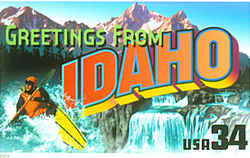


Idaho Early History
First Early Inhabitants of Idaho

Early history examines the archaeological record that tells the story of the first inhabitants of Idaho. Learn about the prehistory and culture of the first early inhabitants, and what lessons it might teach us about the early history of Idaho.
Idaho First Early Inhabitants Timeline
- 55-38 Million BP - Daniel Axelrod (d.1998), paleobotonist, in 1998 published "Eocene of Thunder Mountain Flora of Central Idaho. (SFC, 8/7/98, p.D3)
- 640000 BC - Volcanic eruptions in northwest Wyoming, extending to Idaho and Montana, created a caldera some 40 miles long and 30 miles wide. The surface collapsed thousands of feet into a magma pool and marked the area later known as Yellowstone. Continuing eruptions caused climactic changes around the world. (SFEC, 10/18/98, p.T5) (HC, 10/10/06)
- 8,000 - 10,500 BP - Paleo-Indian big game-hunters, with Clovis (11,500 to 12,500 BP), Folsom (10,500 to 11,000 BP), and Plano (8,000 to 10,500 BP) cultures, live in what is now Idaho. Paleo-Indian Big Game Hunters. This group received its name from the large game, such as the mastodon, that they hunted for food. Along with hunting large animals, the Big-Game Hunters fished and gathered wild plants. They lived a nomadic life and followed the migratory patterns of the animals they hunted. They used bones, wood, and stone to create weapons and tools including knives, scrapers, and axes. This tool-making ability evolved throughout the period. Clovis Culture. As the numbers of large mammals decreased, the native lifestyle would evolve into a small-game hunting society, and the Clovis people developed a unique type of spear point.
- 10,000 BC- Paleo-Indian Era (Stone Age culture) the earliest human inhabitants of America who lived in caves and were Nomadic hunters of large game including the Great Mammoth.
- 9000 BC - Clovis Culture (named after artefacts found at Clovis, New Mexico. These people used a distinctive type of fluted arrow point
- 7500 BC - Folsom Culture (named after artefacts found at Folsom, New Mexico. These people used flint arrow point in the shape of a leaf)
- 7000 BC - Archaic Period in which people built basic shelters and made stone weapons and stone tools
- 200 to 8,000 years ago - Archaic-Indian culture, with permanent houses (5,000 years ago) and bows and arrows and pottery (300 to 1,500
years ago) coming into use., to present. During this period, Idaho experienced a big climate change that affected the land and its people dramatically.
During this time, the entire planet experienced a warming trend that lasted for nearly 2,000 years.
Large mammals, such as the woolly mammoth and the mastodon, became extinct. The ice in the mountains melted, making the rivers of the area much larger. Rivers became increasingly important in the lives of the Archaic People as their diet staples shifted to fish and mussels. These people also hunted animals and gathered wild plants. There is also evidence that the people of this era traded with nearby tribes.
The Archaic-Indian culture began using permanent houses 5,000 years ago and bows, arrows and pottery 300 to 1,500 years ago. They lived in small, self-sufficient family units where men and women had specific duties.
Women traditionally did the cooking and gathering of roots, seeds, and berries. Men were responsible for hunting and making tools. The Archaic People had not yet learned how to grow crops, so they depended entirely on their hunting, fishing, and gathering skills to survive. - AD 500 - 1805, As descendants of the earlier Archaic tribes mixed with the in-migration of desert people during this time, they formed what are known as the modern tribes of Idaho. These people were the ancestors of the tribes that existed at the time of Lewis and Clark's journey through Idaho in 1805.
- 200 to 260 years ago - Shoshone bands obtain horses for transportation but are decimated by smallpox spread from European sources.
- 1501 - The Spanish explorers claim lands for the Spanish monarchy
Early History of Native Americans in Idaho
The Indigenous People of Idaho
The names of the Idaho tribes included the Lemhi Shoshone Bannock, Nez Perce, Salish (Flatheads), Paiutes and the Piegan Indians. The Snake River Plains Indians evolved into the Bannock and Shoshone tribes, whilst the Northern Idaho Natives evolved into the Nez Perce and other tribes. The Bannock originated in Western Idaho and spoke the Northern Paiute language. The Bannock tribe developed a horse culture and were closely associated with the Northern Shoshone with whom they eventually merged.
Prior to the arrival of European and Mexican explorers, scientists estimate that around 8,000 Native Americans lived in the area we now call Idaho. These people can be divided into two distinct cultural groups: the Plateau and the Great Basin.
The Nez Perce, Shoshone, and other Native American Indian tribes moved into Idaho during the 1700s. One group lived along the Snake River Plains, and the other in Northern Idaho. The Snake River Plains Natives evolved into the Bannock and Shoshone tribes, while the Northern Idaho Natives evolved into the Nez Perce and other tribes. The Shoshone's settled throughout the mountains and Snake River Plains of Idaho, and the other mountains and plains in states near South East Idaho.
Plateau tribes included the Nez Perce, Coeur D'Alene, Flathead, Kutenai, Palus, Cayuse, and Kalispel, and these groups lived in the forests, prairies and along the rivers. About half their diet was fish, and the other half came from large game animals and roots. These groups interacted with Plains tribes and eventually came to be dependent upon annual buffalo hunts, and adopted many Plains Indians traits.
The Great Basin (or desert) tribes included the Shoshone-Bannock and the Northern Paiunte. These groups lived in desert regions and lived on nuts, seeds, roots, cactus, insects and small game animals and birds. These tribes were also influenced by Plains tribes, and by 1800 had adopted some of their customs, including the use of horses for hunting.





